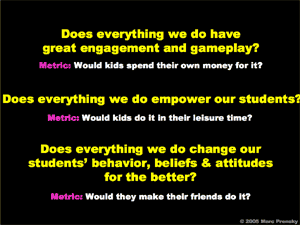 I’ve had an interesting exchange with Marco Polo (Autono Blogger), through comments on a blog I posted a couple of days ago, Some Quotes from Presentation Slides. The quotes were from various presentation slides I’ve capture over the last many weeks with my digital camera. One set of quotes implies that we should allow our students to take the lead in what and how they learn. Here are the quotes, which are from a Marc Prensky presentation.
I’ve had an interesting exchange with Marco Polo (Autono Blogger), through comments on a blog I posted a couple of days ago, Some Quotes from Presentation Slides. The quotes were from various presentation slides I’ve capture over the last many weeks with my digital camera. One set of quotes implies that we should allow our students to take the lead in what and how they learn. Here are the quotes, which are from a Marc Prensky presentation.
Does everything we do have great engagement and gameplay?
Would kids spend their own money for it?Does everything we do empower our students?
Would kids do it in their leisure time?Does everything we do change our students’ behavior, beliefs & attitudes for the better?
Would they make their friends do it?
It is common to believe that institutions are part of the problem, that we need to break them, and allow students to rebuild their learning experience. This is a dangerous notion, although there is much about it that is true, in my opinion. Still, Marco, in his latest comment, says:
The difficulty I see and face, is that, probably due to their incarceration in high school, my students have developed bad study habits and self-sabotaging behaviour. I’ve tried letting them take the lead, but that didn’t really work – they just think I’m goofing off, then they goof off too, and nothing productive gets done.
Read the entire exchange
It is a fine line that we walk, razor fine.
One of the most compelling ideas that came out of Got Game (by John Beck and Mitchell Wade) and the media around it, was the role of the boss. In many video games, the player must face a large and powerful monster before moving to the next level. The next level is where they want to be, and they will fight that monster again, and again, and again, until they learn how to get past him. That monster is always called, the boss.
To the video game generation, the boss is someone who is a barrier between the player and where the player wants to be. Beck suggests that the supervisor (or teacher) should instead become the strategy guide or cheat sheet, a document players download from the Net or purchase in video game stores. They include shortcuts through the barriers of the game.
Perhaps our challenge, as teachers, is to compellingly define and describe that next level, create a place where the players want to be. If we do it right, then our students will come to us for the short cuts (curriculum) that help them get there. Classroom learning, will always require a leader. But is it better to push a stalled car, or steer one that has someplace to go.

But is it better to push a stalled car, or steer one that has someplace to go. Well, of course I’d rather steer one that has someplace to go. But here’s my sitatuion as I see it: I’m faced with a garage-full of stalled cars in various states of disrepair. And I’m expected to do something about them!
I like this: Perhaps our challenge, as teachers, is to compellingly define and describe that next level, create a place where the players want to be
If that is my challenge, then I have no idea how to do that.
OK! I was a history teacher, and let’s say that my students are expected to be able to answer the following questions at the end of my unit on the Civil War. (We call it the War of North Aggression) 😉
At the beginning of the class, I bring an old wooden box on my desk and say that a local historian has just discovered this box while going through an estate sale, and to her amazement, it was full of letters written home by soldiers, both blue and gray, describing their ordeals and their missions.
Now class, at the end of this unit we’re going to fill that box with those letters, and you’re going to write them, and we’re then going to put this box in the local public library for people to read. What do you think soldiers would be talking about as this sit in the mud writing home?
and the unit begins.
How far off is this?